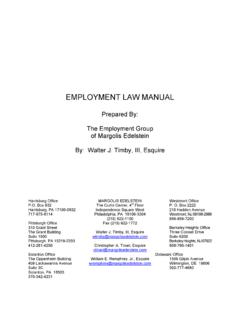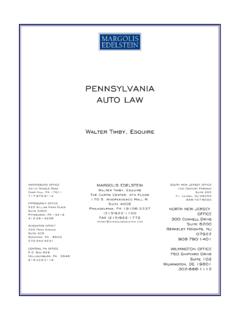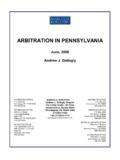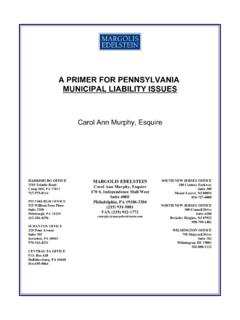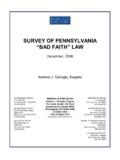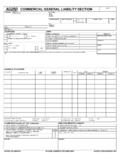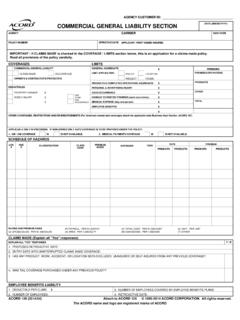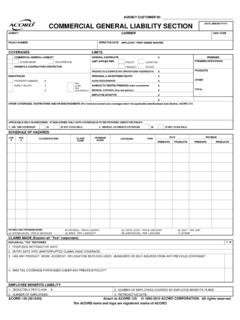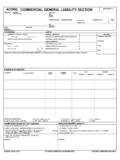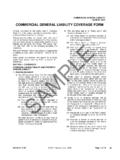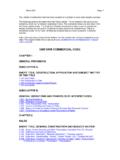Transcription of COMMERCIAL GENERAL LIABILITY COVERAGE EXCLUSIONS …
1 COMMERCIAL GENERAL LIABILITYCOVERAGE EXCLUSIONS UNDER PENNSYLVANIA LAWA pril, 2008 HARRISBURG Box 932 Harrisburg, PA 17106-0932717-975-8114 PITTSBURGH OFFICE525 William Penn PlaceSuite 3300 Pittsburgh, PA 15219412-281-4256 SCRANTON OFFICE220 Penn AvenueSuite 305 Scranton, PA 18503570-342-4231 Andrew J. GalloglyMARGOLIS EDELSTEINThe Curtis Center, 4th FloorIndependence Square WestPhiladelphia, PA 19106-3304(215) 931-5866 FAX PA Box 628 Hollidaysburg, PA 16648814-224-2119 WESTMONT Box 2222216 Haddon AvenueWestmont, NJ 08108-2886856-858-7200 BERKELEY HEIGHTS OFFICE300 Connell DriveSuite 6200 Berkeley Heights, NJ 07922908-790-1401 WILMINGTON OFFICE750 Shipyard DriveSuite 102 Wilmington, DE 19801302-888-1112 TABLE OF CONTENTSE xpected or Intended Injury.
2 1 The Occurrence Requirement ..3 Contractual LIABILITY ..4 Liquor LIABILITY ..5 Workers Compensation ..6 Employers ..8 Aircraft, Auto or Watercraft ..12 Mobile Equipment ..14 War ..14 Damage to Property ..15 Damage to Your Product ..17 Damage to Your Work ..18 Impaired Property ..18 Product Recall ..19 The Occurrence Requirement ..20 Personal and Advertising Injury ..21 Electronic Data ..22 Fire Legal LIABILITY COVERAGE ..221 This article is intended to provide a brief overview of the EXCLUSIONS commonly found withinCoverage A of the COMMERCIAL GENERAL LIABILITY (CGL) COVERAGE Form and the interpretation ofthose EXCLUSIONS by the insurance industry and the Pennsylvania courts.
3 While the applicability ofpolicy EXCLUSIONS to any given set of facts must obviously be determined on a case by case basis, andwill generally be governed when determining an insurer s defense obligations by the factualallegations of a plaintiff s complaint, the aim of this article is to provide the claims professional withgeneral guidance for use in identifying those situations in which the EXCLUSIONS might apply, andthose in which they will the applicable policy language will differ in some cases, this article will addressthe various CGL EXCLUSIONS as they commonly appear in current ISO policy forms, stating that thecommercial GENERAL LIABILITY insurance COVERAGE provided by such policies does not apply to thefollowing:a.
4 Expected or Intended Injury Bodily injury or property damage expected or intended from the standpoint of theinsured. This exclusion does not apply to bodily injury resulting from the use of reasonableforce to protect persons or property. First and foremost, it must be recognized that this is not an intentional act exclusion andshould not be referred to as such. It does not apply merely because the insured commits anintentional act ( , putting down a tool box in a location where someone later falls over it) but onlywhere the resulting injury or damage was intended by the insured.
5 This important distinction wasrecognized by the Supreme Court in Eisenman v. Hornberger, 264 673 (Pa. 1970), in whichthe insured and several teenage companions broke into the plaintiffs home and stole a quantity ofliquor. To avoid detection while in the darkened house, the group lit its way with matches ratherthan turning on the lights, dropping them to the floor as they burned down. One of the matcheslanded in an upholstered chair which, after smoldering for several hours, erupted in flames whichdestroyed the entire house.
6 It was held that a homeowners policy exclusion barring COVERAGE fordamage caused intentionally by the insured did not apply because there was no basis to conclude thatthe insured intended to set fire to the property when dropping the matches, the Court recognizing thedistinction between intending an act and intending the result. Although some courts draw a distinction between the two, the terms expected and intended are considered synonymous in Pennsylvania. The use of the phrase the insured, rather than an or any insured, is construed asmeaning that COVERAGE is barred only where the injury or damage was intentional from the standpoint2of the particular insured seeking COVERAGE .
7 COVERAGE remains in force for innocent co-insureds whodid not themselves intend the injury. Conversely, policies excluding COVERAGE for the intentionalinjuries of an or any insured are interpreted as barring COVERAGE to all insureds if any one of themengaged in the excluded conduct. GENERAL Accident Ins. Co. of America v. Allen, 708 828( 1998). For this exclusion to apply, the insured need not act with the specific intent to cause theprecise injury or damage which in fact resulted; it is sufficient if the insured expected or intendedto cause injury or damage of the same GENERAL type.
8 United Services Automobile Ass n. , 517 982 ( 1986), appeal denied, 528 957 (Pa. 1987). For the exclusion to apply, the resulting injury must have either been intended, or it musthave been substantially certain to follow from the insured s conduct. It is not enough that theinsured should have reasonably foreseen the injury which his actions caused. Id.; Erie InsuranceExchange v. Fidler, 808 587 ( 2002). The law is not fully developed regarding theextent to which this principle can result in a finding of COVERAGE where the victim suffers animprobable or freak injury due to an insured s intentional actions, such as permanent brain damagefrom a punch in the nose.
9 The Pennsylvania courts have held that an intent to cause injury will be inferred as a matterof law in cases involving particularly reprehensible acts such as engaging in sexual relations withminors, but have not extended that rule to other contexts. Aetna Casualty & Surety Co. v. Roe, 94 ( 1984); Erie Insurance Exchange v. Claypoole, 673 348 ( 1996). Although the courts do not use the phrase inferred intent in cases outside of the sexualmolestation of minors context, it is also well established that an insured is chargeable withknowledge of the natural and obvious consequences of his actions, and will not be permitted to arguethat he had no intent to cause them.
10 For example, in Donegal Mutual Ins. Co. v. Ferrara, 552 ( 1989), in which the insured intentionally kicked a policeman in the crotch, but deniedthe intent to injure him, the court held that injury to the officer s genitals was substantially certainto result from the insured s actions and that an intentional injury exclusion barred COVERAGE . Thisconcept has also been employed frequently in gunshot cases. An insured s voluntary intoxication may be considered in determining whether an injury issubject to this exclusion .
